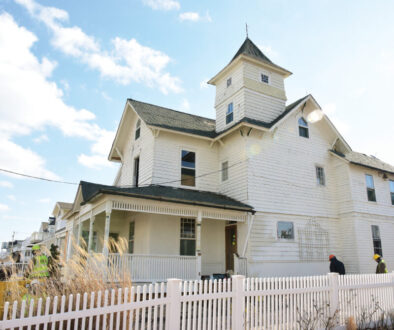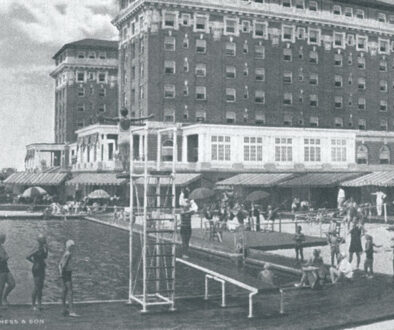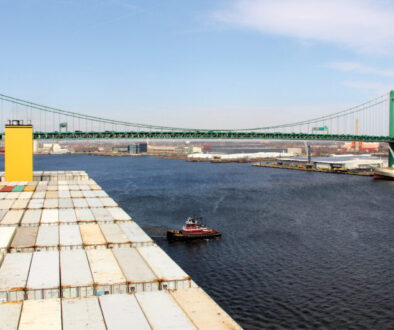Raising the Bar
“Well, everything dies, baby, that’s a fact. But maybe everything that dies someday comes back.”
—Bruce Springsteen

The news spread fast, like reports of a local ascension. For seafood lovers in Cape May, the resurrection of Mayer’s Bar & Restaurant was a near-transcendent experience.
In April, to the collective joy of local diners, the place reopened as Mayer’s Tavern. The Laudeman family of Lobster House fame has turned the former rough-and-tumble hang into a bright little bistro, still unpretentious, with an updated menu that remains refreshingly simple, affordable, and as this diner will attest, pretty darned scrumptious.
No Dive Zone
For decades, Mayer’s was justly famed for its scallops—and no wonder. This was a fisherman’s bar, with a very discerning clientele, at least when it came to seafood and suds. Under the ownership of Edwin and Jean Mayer, the place was open almost round the clock, starting at 5am each day so men on their way to sea could grab an eye-opener and a bag lunch to go, and closing at 3:00 or 4:00 in the morning, just long enough for staffers to swab the deck, polish the bar tops, and empty the trash.
Many who welcomed the return of Mayer’s remember it as a dive bar—and most meant that as a term of endearment. But the description did not sit well with Tracey Bolton of Medford Lakes, who is more than a casual observer.

“It was not a dive bar,” insists Bolton, granddaughter of the Mayers. “It was a family place that just happened to have a bar.
“For one thing, you weren’t allowed to curse—my grandfather would literally pick a guy up and throw him out the door for swearing. And you had to be respectful to women.” As she recalls, Edwin Mayer was always nattily dressed, in wingtip shoes and a buttoned-down shirt. Inevitably, Bolton likens the bar to television’s Cheers, a place where everyone knew your name—even if your name was “Stringy.”
That colorful character, Bolton says, was a fisherman who would bring candy and licorice for the little girl and her brothers. Men like Stringy “probably were alcoholics, always at the bar, but there was a loyalty there. They were like family.”
Equipped with a classic brass foot rail, the bar held up about 30 patrons. There were also a few scattered tables and chairs, and a carved wooden sign pushing the “whale-sized sandwiches.”
“The place was always packed,” says Bolton.
From Baker to Barkeeper
Ed Mayer of Philadelphia was a baker and the son of a baker. He worked at Liberty Cake Company on Lancaster Avenue, and might have gone on to run his father’s business if Cupid hadn’t intervened. On a fishing trip to South Jersey, Ed met Catherine “Jean” Pettit, a Millville lass 13 years his junior. He was smitten. The two married and set up house in Villas. Jean was pregnant with her second daughter, Nancy, when the couple learned that a Mr. Weiszer, a local barber who also owned a bar, was selling said bar at Schellenger’s Landing, overlooking Spicer’s Creek in Cape May.
“I was three months old when they settled, on my mother’s 24th birthday, November 13, 1950,” says Nancy Mayer Shearer of Mt. Laurel. “They both tended bar, they both cooked, they both did the cleaning. They worked really hard.”
For Nancy and her sister, JeanAnn, the bar was their home and also their playground. “We would ride our tricycles around the bar. That was our Indy 500. And yes, my dad would call people down for their language, [saying] ‘I’m trying to raise two girls here. If you can’t mind your language, you can leave.’”
The building’s second floor had 11 rooms that rented for three dollars a night in the summer only (no heat). The Mayer family lived in two rooms attached to the bar. “I slept in a crib until I went to kindergarten,” says Nancy, “and the only reason I have no other siblings is because my sister slept between Mom and Dad.”
Eventually, the girls were pressed into service in the family business. “We stood on stools and washed dishes. We made beds and changed beds and cleaned bathrooms. We were good at it.”
Courtesy of the bar patrons, they also learned about life. “A man would come in for a late lunch—just dad, mom, and the kids—and a few hours later he’d be back with his girlfriend. You learned early, and sometimes you learned the hard way. There was a phone booth out back, and if Pauline the hairdresser called and asked if her husband was there, I’d say, ‘Wait a minute, let me check. Is Doug here? No, ma’am, he said he’s not here.’”


Though Mayer’s was open into the wee hours, even then some patrons had to be gently ushered to the door. As Ed Mayer would say, “If you can’t get drunk by midnight, there’s something wrong with you.”
Despite being raised in a bar, Nancy says, she and JeanAnn “were really sheltered. My parents were strict. They didn’t want us to grow up and have a checkered past.”
One big bang could have put an end to the whole enterprise. On a Monday morning in 1959, “for the first time in ages,” according to Nancy, hard-working Jean Mayer decided to linger in bed rather than get up and tackle the laundry.
“God works in mysterious ways,” says Nancy. “That was the morning the heater blew up. I went to Lower Cape May Regional at the time, and we could hear the explosion from there.”
The blast and subsequent fire meant extensive repairs to the lower level, and to cut costs, Ed and Jean covered the bar’s arched sunburst windows with plywood instead of replacing them. During the recent renovation of Mayer’s, those windows were rediscovered and restored.
The Next Chapter
Last call for the Mayers sounded in November 1974. “My dad had health problems, and he and Mom decided to get out of the business and have some enjoyment in life,” says Nancy. They offered the bar to Nancy, but she was getting married, and her parents said, “Do you want a bar or do you want to get married? You can’t have both.”
“They say love is blind—I didn’t know it was deaf and dumb as well,” Nancy says with a laugh. “I opted to pass up the bar. But in retrospect, it was a good decision. I had watched my parents work 24/7 all those years, like ships passing in the night. I couldn’t foresee doing that the rest of my life.” Along with many of the staff, however, she stayed on to work for the new owners, Bruce and Carl Axelson, longtime friends of the family who chose not to change the establishment’s name.
Under the Axelsons, reportedly, the real “dive bar” era began (Carl Axelson recently passed away, and no other members of the family could be reached for this article). Presumably, the ban on blue language was lifted, there were no children underfoot, and the demand for Shirley Temples dropped precipitously. As the years and decades passed, Mayer’s took on the swagger of a two-fisted seaman’s bar. It became known for its knockdown fights and reportedly, a shooting that left a bullet hole in the wall.
Perhaps most egregiously, says Nancy, patrons would actually steal the toilet paper, passing it to co-conspirators through the bathroom windows.
Lobster House owner Keith Laudeman remembers those days. He ran a scallop boat in the 1970s, and like most others in the trade, occasionally stopped into the bar. “We all used to go there, and yeah, it was rough. What do you expect? It was a bunch of commercial fishermen.”
But the food remained first-class, and the patrons unstintingly loyal. In online comments, Mayer’s was called “one of the top 30 best dive bars in America”—see, it is a compliment!—and “best in the nation, a great place for a couple of cold ones and a game on TV.” Other nostalgic reviews praised the bar’s scallops (“seriously, the best”). Another confirmed Mayer’s rowdy reputation, but observed wryly, “The bar stools don’t break like they do in the movies.”
In 2015, after 30 years, the Axelson family closed up shop. The property was eventually sold to Laudeman, though at first, he wasn’t sure he wanted to take on the tumbledown
property. “I hemmed and hawed, and ended up buying it with no plan whatsoever. It wasn’t in very good shape,” he says.
“The place hadn’t been occupied in a year,” agrees Laudeman’s wife, Sue. “A cat colony was living underneath. The building needed considerable structural work.” When a contractor pulled down the outside siding and inside paneling to reveal those sunburst windows, “it was really an exciting find.”
A Simple Recipe
Two-plus years of renovations transformed Mayer’s into what you’ll find today—a gleaming little gastropub with a short-and-sweet menu: only five entrees, a handful of appetizers, a number of small-plate offerings, and a “shellfish tower” of stacked shrimp, clams and oysters.
Mayer’s now operates under the direction of Alex Laudeman, Keith and Sue’s daughter, who studied at the Institute of Culinary Education in New York and most notably worked at Esca, a top-rated Italian seafood restaurant in Manhattan’s Theatre District.
At Mayer’s, “the scallops are obviously the big hit,” says Alex. “The burgers are very good. One of my favorite things is the salad, because all the greens are from my sister’s farm (Enfin Farms in West Cape May). It always makes me really happy to put them on a plate, they’re so fresh and delicious.”
Like their predecessors, the Laudemans chose to retain the Mayer name, which continues to glow on a vertical neon sign hanging above the front door. “It makes sense,” says Keith, “because there’s a lot of history there. We’re big into keeping stuff the same.”


“I feel so honored they kept the name,” says Tracey Bolton, who hasn’t visited the new Mayer’s Tavern, but is making plans. “With the reputation the Lobster House has, they could have named it Lobster House II and had that association. They could have called it Crawfish. They could have called it anything, but they called it Mayer’s. We’re happy. I can’t wait to go down there.”
Echoing her father, Alex Laudeman says, “I really didn’t have a plan for Mayer’s when I came here. But I did try to make this a nice place for everybody to come, have a drink and have a good time.” From the crowd witnessed there on a recent weekday evening, the recipe is working just fine.
But please, folks, no cussing.



